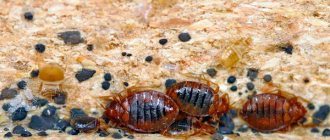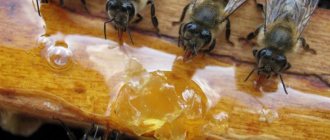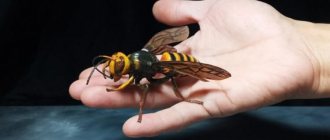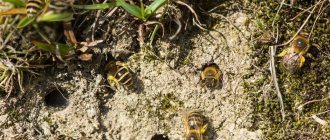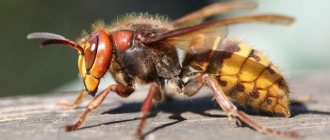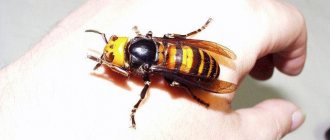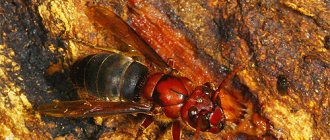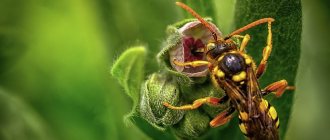Causes
There are several reasons for the development of apiphobia. There are physiological and psychological predispositions that cause the disorder. Let's look at common cases.
Childhood
Fear of wasps, hornets and honey bees occurs in childhood. Children tend to exaggerate their experiences of danger. The threat of physical pain in children's impressionability turns into a phobia. Children learn about the world around them from the words of their parents. The child is afraid of bees and wild wasps because he is sure of their aggressiveness.
Parents talked about bee stings. The child is accustomed to unconditionally believing. The little man is terrified of everything that causes pain. Negative information is deposited in the subconscious - they are dangerous and must be avoided. This is a false attitude. Bees are harmless creatures. They rarely sting people. A meeting with a person ends in death for them.
Children are not able to think rationally. An adult has developed logical thinking. The mind acts as a defense mechanism. Life experience helps an adult overcome mental discomfort. Despite this, fear of wasps, bees and bumblebees can develop in older people.
Fear of anaphylactic shock
People with allergies are predisposed to developing apiphobia . They know about the allergic reaction and may have experienced the consequences. Allergy sufferers fear an allergy attack. On a subconscious level, they avoid life-threatening situations. Bee venom is a strong allergen . An acute reaction (anaphylactic shock) occurs when a small amount enters the body.
The reaction occurs instantly. A person's blood pressure drops. He is in excruciating pain and is suffocating. In the absence of medical care, human life is at risk.
Impressionability
Impressionable people take traumatic events to heart. This is explained by an innate tendency towards apiphobia. Any information in the media is taken on faith. The news of giant killer wasps attacking people is causing panic. Information generated by rumors triggers the mechanism for the development of fear.
Genetic predisposition
In ancient times, there was a threat from wild nature to human health and life. The instinct of self-preservation protected modern man from the inevitable death of the distant ancestors. The behavioral response to danger in modern people is formed at the DNA level . We are afraid of everything that poses a threat.
Some people are more sensitive, others less so. A sensitive subject has an increased risk of developing a phobia.
Why do bees appear in the house?
Of course, no one is surprised by the close proximity of people and bees when it comes to apiaries and beekeepers. But it also happens that wild bees settle on the site. They can make a home in a hollow tree, under the roof of one of the buildings; moreover, bees can even make a nest in the wall of a house. There are several main reasons for insect swarming near human habitation:
- there are many flowering plants on the site that emit a rich aroma;
- on the territory there are trees with hollows, deposits of boards, wooden buildings not painted or impregnated with special solutions, which attract bees as the most suitable for home improvement (they settle on verandas and sheds, in the attic or under the roof of the house).
Lots of flowers in the area
Another reason that bees settled on the site is the separation of part of the swarm living nearby. The new colony is looking for a place for a home, and the main factors influencing the choice are a sufficient amount of food and silence.
Stages and development
The development of a psychological disorder begins differently for each person. Timely diagnosis will help eliminate the problem. Often, a predisposition to apiphobia is formed in childhood. The trigger for the disorder can be a bad experience with bees. The following stages of phobia are distinguished:
- formation of free fear (expectation of troubles, attitude towards a bad outcome of events);
- the formation of fear in an exaggerated form (development of a phobia);
- the appearance of a panic reaction under normal conditions.
At the first stage of development of a phobia, a person becomes acquainted with an insect that causes subconscious fear. Free fear is formed in childhood. The child was taught that wasps sting, causing terrible pain. On a subconscious level, he expects trouble. A false belief is formed that a bee sting is inevitable. Once stung, a person remembers the pain. Childhood memories of the pain of a bite trigger the process of psychological distress in adults.
Fear in an exaggerated form is characterized by the appearance of seizures. A state of panic occurs at the sight of flying insects. A person perceives the sound of buzzing as a threat.
At the third stage of development of a phobia, a person begins to experience panic under normal conditions. Panic occurs when there is no threat. The stage is characterized by auditory hallucinations in the form of a characteristic buzzing sound.
Evidence of attack
At the entrance one discovers the persistent attempts of strangers to penetrate into the hitherto impregnable fortress - into the protected territory. Using roundabout maneuvers, they manage to get into the reserved, not too rich, neighbor's bins. Having filled her goiter to capacity, the shameless sneak leaves the hive without hindrance. Everyone wants to eat. The vigilant sentries are surprisingly strict with those entering. For some reason they don’t care at all about those who leave. Apparently, during the minutes of being in the owners’ apartments, they become saturated with their aura and are accepted as their own.
Symptoms
The disease progresses differently in each individual person. Much depends on the individual characteristics of the body. Symptoms of fear of insects are similar to other psychological disorders of this kind. The following symptoms are characteristic of apiphobia:
- dizziness;
- weakness in the body when encountering an insect;
- increased blood pressure;
- increased heart rate;
- disorientation in space;
- increased sweating;
- fear turning into panic.
When meeting insects, a person loses self-control. Fear makes you behave inappropriately. Sometimes there is a strong hysteria, a seizure. A severe form of phobia is expressed in uncontrollable attacks of aggression. Apiphobe begins to deliberately destroy bees and their nests. He recklessly exposes himself to great danger.
Detection of at least three of the above symptoms is a reason to seek psychotherapeutic help. Self-medication of a phobia will not bring results . This can make the situation worse.
To pacify bees, use ordinary dewdrop.
Regular peppermint, which is sold in every pharmacy, should be in the arsenal of an amateur beekeeper. It is a good remedy for reducing bee aggression.
Plain water is poured into the bottle with mint drops added. The bees are irrigated with a solution from a spray bottle over the frames and go inside the hive.
The advantage is that there is no need to light the smoker .
Minus - it is more suitable for southern breeds of bees . You need to be careful with water during the honey collection period.
Stages of treatment
Correction and elimination of the root cause of the disease is carried out by a specialist. He must have a license to practice psychotherapy.
Therapy is carried out in stages. At the initial appointment, the specialist determines the cause. The fear of stinging wasps did not arise without reason. The doctor finds out what was the triggering factor. When the cause is determined, the specialist makes a diagnosis. After this, treatment is prescribed.
At the second stage, the psychotherapist selects a technique. An individual program is drawn up for the patient . If necessary, medications are prescribed. Drug therapy helps relieve nervous tension. This minimizes the risk of panic conditions.
The third stage consists of psychotherapy sessions. The patient undergoes hypnosis and engages in auto-training. He regularly attends cognitive behavioral therapy classes. A long course of therapy is necessary to achieve better results. The therapy includes ten sessions . At the final stage, re-diagnosis is carried out. If the patient's condition is still unstable, the doctor prescribes a second course of therapy.
Treatment methods
The disease can be overcome at any degree of complexity. It is important to make a timely diagnosis. A person’s self-awareness plays a significant role. If the patient has thought about how to stop being afraid of bees and wasps, he is on the road to recovery.
The disorder will not go away on its own. False installation should be abandoned. Phobia of honey bees and wasps can develop into a complex mental disorder. This condition is difficult to correct.
It is important to begin treatment at the first sign of a disorder. The following methods of treating phobias are available:
- hypnotherapy;
- behavioral therapy;
- autogenic training.
In addition to psychotherapy, the patient is prescribed medications. Medicines relieve depression and reduce anxiety.
Medicines are not the mainstay of treatment. They can only relieve symptoms. A full course of psychotherapeutic treatment brings real results.
Behavioral therapy
The therapy method is widely used to correct various phobias. During the session, the specialist tries to help patients realize their deepest thoughts and feelings. A person must admit - “ I am afraid of wasps, hornets and bees .” Awareness of the problem promotes recovery.
A deep analysis of social emotions, acquired skills, innate and acquired instincts helps to achieve results. The following techniques are used during the session:
- learning new forms of behavior;
- elimination of inappropriate forms of behavior;
- asychological correction;
- building confidence;
- formation of a sense of responsibility.
As a result of psychotherapy, a person changes his attitude towards life and the people around him. He gains valuable skills to control behavior.
Autotrainin
Autogenic training is a self-hypnosis technique . It helps to calm down and relieve mental stress. A program consists of sequential instructions. The goal of autotraining is to achieve an autogenic state. Relaxation is accompanied by muscle relaxation. There are various options for training programs. They cure advanced cases.
The auto-training technique is effective if a person is committed to treatment. To achieve results, self-control is necessary. A person must make an effort, constantly work on himself.
Hypnosis
People with severe mental illness are subject to hypnosis. During the session, the patient is put into a trance. This allows you to weaken psychological barriers. In a relaxed state, a person calmly perceives the situation and is easily suggestible.
A hypnotherapy session is conducted by a suitably qualified specialist. Patients perceive hypnosis more easily . They don't have to put in effort for results. To achieve a therapeutic goal, a psychotherapist works. Work and responsibility for the result are focused on him.
During the session, the specialist changes the body’s attitude. He is talking to the patient. During the conversation, a detailed analysis of the phobia takes place. Under the experienced guidance of a psychotherapist, a person understands his fear. Understands the reasons for its appearance. The specialist teaches the patient to respond to the object of fear with complete relaxation. The attacks stop after the first session. Treatment with hypnosis is characterized by high effectiveness. There are no relapses after a course of therapy.
Extreme but necessary measures - how to poison bees
How to get rid of your neighbor's bees if you don't have the time or desire to do everything according to the law? When bee control methods fail, property owners can take extreme measures. In cases where insects sting and behave extremely aggressively, this method of solving the problem will be completely legal. How to poison bees so that they do not interfere with a full life:
- You can start the fight by using saline solution . Salt, which is more than 2.5% in food, will lead to the death of the insect.
- We build traps from bottles. Filling containers water-salt solution and add honey. Plastic traps are hung along the fence.
- An extreme method would be to use insecticides diluted in water and mixed with 150 ml of honey. For 25 liters of water you will need only 3 ampoules. The toxic mixture is poured into traps that are installed throughout the site.
What else are bees afraid of and how to get rid of them? This question worries many summer residents:
- Of course, anti-mosquito lamps . The principle of operation of the lamps is to emit ultraviolet light, which attracts insects. As soon as a bee lands on the repeller, it receives an electric shock and dies. It is advisable to install several anti-mosquito lamps on the side where the hives are located.
- Ultrasonic repeller . The operating principle of the device that repels bees is to create a magnetic field that repels and kills insects. The repeller operates from an ordinary or solar battery. A significant advantage is the extensive radius of influence. The disadvantage of the device is its high cost.

